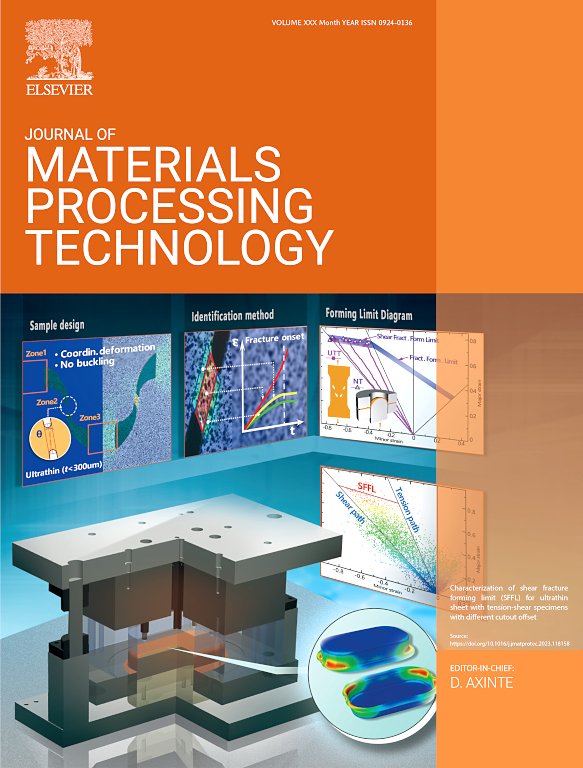研究搅拌摩擦添加式制造的 AA2024 构件以及材料流动对增强表面间结合力的影响
IF 6.7
2区 材料科学
Q1 ENGINEERING, INDUSTRIAL
Journal of Materials Processing Technology
Pub Date : 2024-09-27
DOI:10.1016/j.jmatprotec.2024.118611
引用次数: 0
摘要
摩擦搅拌快速成型技术(FSAM)是一种固态连接工艺,其工作温度低于材料的熔点,避免了熔融方法的缺点。在 FSAM 中,表面间的结合对制造强度至关重要,并受到界面上材料流动的影响。本研究以覆铝板为示踪剂,研究了扁平(方形)和光滑(螺纹锥形)销钉以及旋转速度对材料流动的影响。研究还分析了铸件的微观结构、微观纹理、机械性能以及锻造力在 FSAM 中的作用。锻造力超过 7000 牛时,铸件无缺陷。带螺纹的锥形销钉会导致覆铝板向上移动,而方形销钉则会导致覆铝板破碎和分布,从而提供出色的表面间结合。在顶层观察到细化的晶粒结构(∼5 µm)。螺纹锥形销在焊接方向的最高拉伸强度为 392 兆帕(成型效率为 80%),方形销在成型方向的最高拉伸强度为 358 兆帕(成型效率为 75%)。ODF 中的强γ 纤维表明延展性更好,伸长率最多可提高 60%。当前的研究将为选择合适的工艺参数提供指导,进而减少通过搅拌摩擦快速成型制造铝合金过程中的试错。本文章由计算机程序翻译,如有差异,请以英文原文为准。
Investigating the friction stir additively manufactured AA2024 build and the influence of material flow in enhancing the inter-surface bonding
Friction Stir Additive Manufacturing (FSAM) is a solid-state joining process that operates below the material’s melting point, avoiding the drawbacks of fusion-based methods. In FSAM, inter-surface bonding is crucial for the build strength and is influenced by material flow at the interface. This study examines the influence of flat-faced (square) and smooth (threaded conical) pins, along with rotational speed, on the material flow, using Al-clad as a tracer. It also analyses the microstructure, micro-texture, mechanical properties of the builds, and the role of the forging force in FSAM. Defect-free builds were achieved with a forging force above 7000 N. The threaded conical pin caused upward migration of Al-clad, while the square pin led to fragmentation and distribution, offering excellent inter-surface bonding. Refined grain structures (∼5 µm) were observed in the top layers. The highest tensile strengths were 392 MPa in the weld direction (80 % build efficiency) with the threaded conical pin, and 358 MPa in the build direction (75 % build efficiency) with the square pin. Strong γ-fiber in ODFs indicates better ductility, with up to 60 % improvement in elongation. The current research shall guide the selection of appropriate process parameters and, in turn, reduce trial-and-error during manufacturing aluminum alloys through friction stir additive manufacturing.
求助全文
通过发布文献求助,成功后即可免费获取论文全文。
去求助
来源期刊

Journal of Materials Processing Technology
工程技术-材料科学:综合
CiteScore
12.60
自引率
4.80%
发文量
403
审稿时长
29 days
期刊介绍:
The Journal of Materials Processing Technology covers the processing techniques used in manufacturing components from metals and other materials. The journal aims to publish full research papers of original, significant and rigorous work and so to contribute to increased production efficiency and improved component performance.
Areas of interest to the journal include:
• Casting, forming and machining
• Additive processing and joining technologies
• The evolution of material properties under the specific conditions met in manufacturing processes
• Surface engineering when it relates specifically to a manufacturing process
• Design and behavior of equipment and tools.
 求助内容:
求助内容: 应助结果提醒方式:
应助结果提醒方式:


